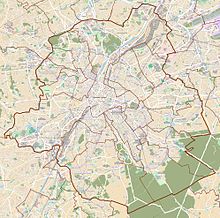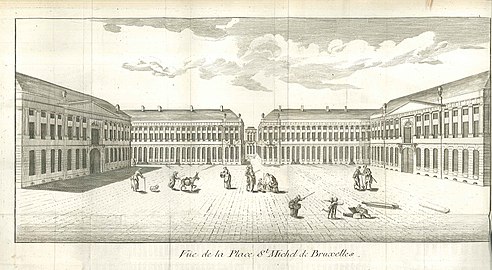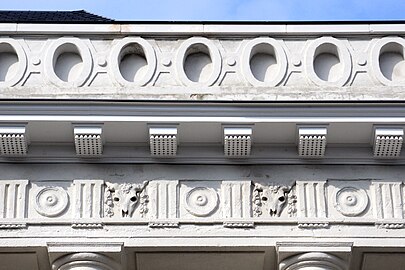
The City of Brussels is the largest municipality and historical centre of the Brussels-Capital Region, as well as the capital of the Flemish Region and Belgium. The City of Brussels is also the administrative centre of the European Union, as it hosts a number of principal EU institutions in its European Quarter.

Brussels Park is the largest urban public park in central Brussels, Belgium. Formerly known and still sometimes colloquially referred to as the Royal Park, it was the city's first public park, being originally laid out between 1776 and 1783 in a neoclassical style by the French architect Gilles-Barnabé Guimard and the Austrian landscape architect Joachim Zinner, as part of an urban project including the Place Royale/Koningsplein. The area of the rectangular park is 13.1 ha.

The Royal Saint-Hubert Galleries is an ensemble of three glazed shopping arcades in central Brussels, Belgium. It consists of the King's Gallery, the Queen's Gallery and the Princes' Gallery.
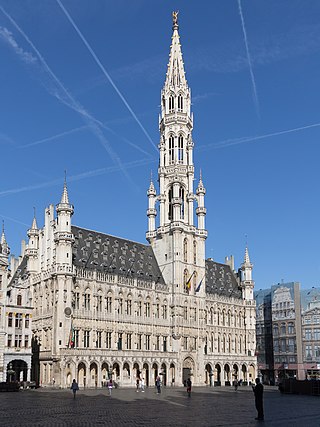
The Town Hall of the City of Brussels is a landmark building and the seat of the City of Brussels municipality of Brussels, Belgium. It is located on the south side of the famous Grand-Place/Grote Markt, opposite the neo-Gothic King's House or Bread House building, housing the Brussels City Museum.

The Academy Palace or Palace of the Academies is a neoclassical palace in Brussels, Belgium. It was originally built between 1823 and 1828 for Prince William II of Orange. Nowadays, it houses five Belgian academies including the Royal Academies for Science and the Arts of Belgium (RASAB). In English, it is also often called the Academy House.

The Congress Column is a monumental column in Brussels, Belgium, commemorating the creation of the Belgian Constitution by the National Congress of 1830–31. Inspired by Trajan's Column in Rome, it was erected between 1850 and 1859, on the initiative of the then-Prime Minister of Belgium, Charles Rogier, according to a design by the architect Joseph Poelaert. At the top of the column is a statue of Belgium's first monarch; King Leopold I, and at its base, the pedestal is surrounded by statues personifying the four freedoms guaranteed under the Constitution. The Belgian Tomb of the Unknown Soldier with an eternal flame lies at its foot.

The Bortier Gallery is a glazed shopping arcade in central Brussels, Belgium. It was designed by Jean-Pierre Cluysenaer in 1847, in a neo-Renaissance style, and opened in the following year. As well as being one of the first European shopping arcades, it is a fine example of the joint use of cast iron and glass.

(Hyppolyte) Louis Alexandre Dechet was a French actor and is regarded the author of the lyrics of the Brabançonne, the Belgian national anthem. His pseudonym was Jenneval, possibly named after the drama Jenneval, ou le Barnevelt français (1769) of Louis Sébastien Mercier.

The Place Royale or Koningsplein is a historic neoclassical square in the Royal Quarter of Brussels, Belgium. Modelled after the so-called French royal square and built between 1775 and 1782, according to a plan of the architects Jean-Benoît-Vincent Barré and Gilles-Barnabé Guimard, to replace the former Palace of Coudenberg, it was part of an urban project including Brussels Park.

The Rue Royale or Koningsstraat is a street in Brussels, Belgium, running through the municipalities of Schaerbeek, Saint-Josse-ten-Noode and the City of Brussels. It is limited to the south by the Place Royale/Koningsplein in the city centre and to the north by the Place de la Reine/Koninginplein in Schaerbeek.

The Church of St. John the Baptist at the Béguinage is a Roman Catholic parish church in central Brussels, Belgium. It is dedicated to Saint John the Baptist.
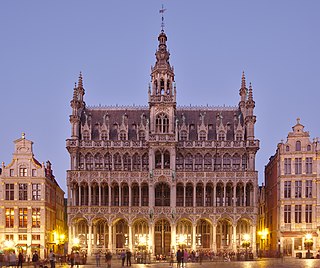
The Brussels City Museum is a municipal museum on the Grand-Place/Grote Markt of Brussels, Belgium. Conceived in 1860 and inaugurated in 1887, it is dedicated to the history and folklore of the City of Brussels from its foundation into modern times, which it presents through paintings, sculptures, tapestries, engravings, photos and models, including a notable scale-representation of the town during the Middle Ages.
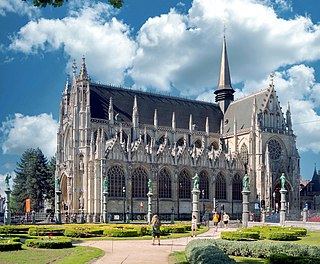
The Sablon or Zavel is a neighbourhood and hill in the historic upper town of Brussels, Belgium. At its heart are twin squares: the larger Grand Sablon or Grote Zavel square in the north-west and the smaller Petit Sablon or Kleine Zavel square and garden in the south-east, divided by the Church of Our Blessed Lady of the Sablon. This area is served by Brussels-Chapel railway station and Brussels-Central railway station, as well as the tram stop Petit Sablon/Kleine Zavel.

The Place de Brouckère or De Brouckèreplein (Dutch) is a major square in central Brussels, Belgium. It was created following the covering of the river Senne (1867–1871), replacing the Temple of the Augustinians, which was demolished in 1893. It is named in honour of Charles de Brouckère, a former mayor of the City of Brussels and professor at the Free University of Brussels, who played a great political role during the Belgian Revolution of 1830. The square measures approximately 50 by 350 metres and is nearly entirely paved.

The Boulevard Adolphe Max or Adolphe Maxlaan (Dutch) is a central boulevard in Brussels, Belgium. It was created following the covering of the river Senne (1867–1871), and bears the name of Adolphe Max, a former mayor of the City of Brussels.
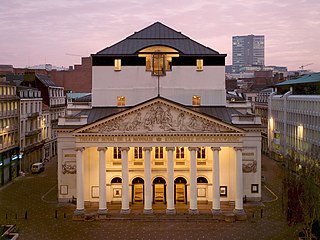
The Place de la Monnaie or Muntplein (Dutch), meaning "Mint Square", is a major square in central Brussels, Belgium. The Royal Theatre of La Monnaie, home to the National Opera of Belgium, is located on this square. It is served by the metro and premetro station De Brouckère on lines 1, 3, 4 and 5.

The Place Rouppe (French) or Rouppeplein (Dutch) is a square in central Brussels, Belgium. It is named in honour of Nicolas-Jean Rouppe, the first mayor of the City of Brussels following the Belgian Revolution of 1830. Rectangular and symmetrical in shape, it is located in the Midi–Lemonnier or Stalingrad Quarter, between the Rue du Midi/Zuidstraat and the Avenue de Stalingrad/Stalingradlaan.

The Place Fontainas (French) or Fontainasplein (Dutch) is a square in central Brussels, Belgium. It was created following the covering of the river Senne (1867–1871). It is named in honour of André-Napoléon Fontainas, a former mayor of the City of Brussels.
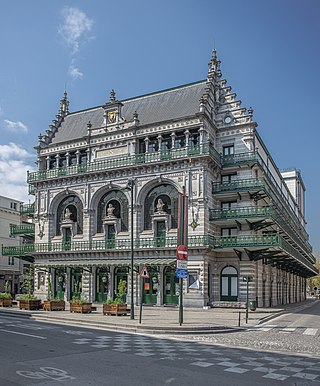
The Royal Flemish Theatre is a theatre in central Brussels, Belgium. It is the anchor of the Flemish theatre company in Brussels, which aims to promote professional theatre in the Dutch language in Belgium and abroad. A place is also made for dance, poetry, music and temporary exhibitions.

The Monument to the Martyrs of the 1830 Revolution, also known as the Pro Patria Monument, is an allegorical monument on the Place des Martyrs/Martelaarsplein in Brussels, Belgium, commemorating the victims of the Belgian Revolution of 1830.

